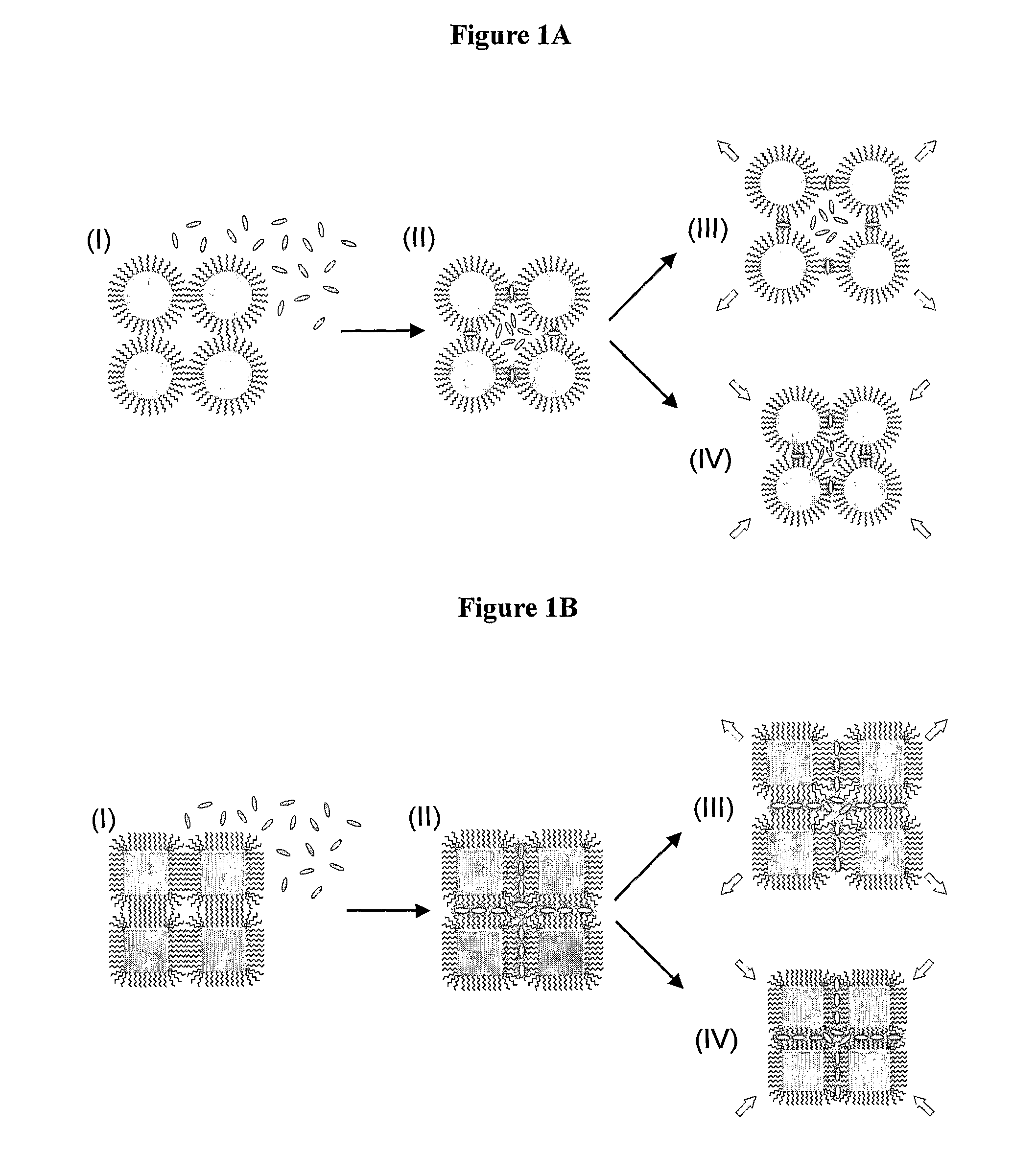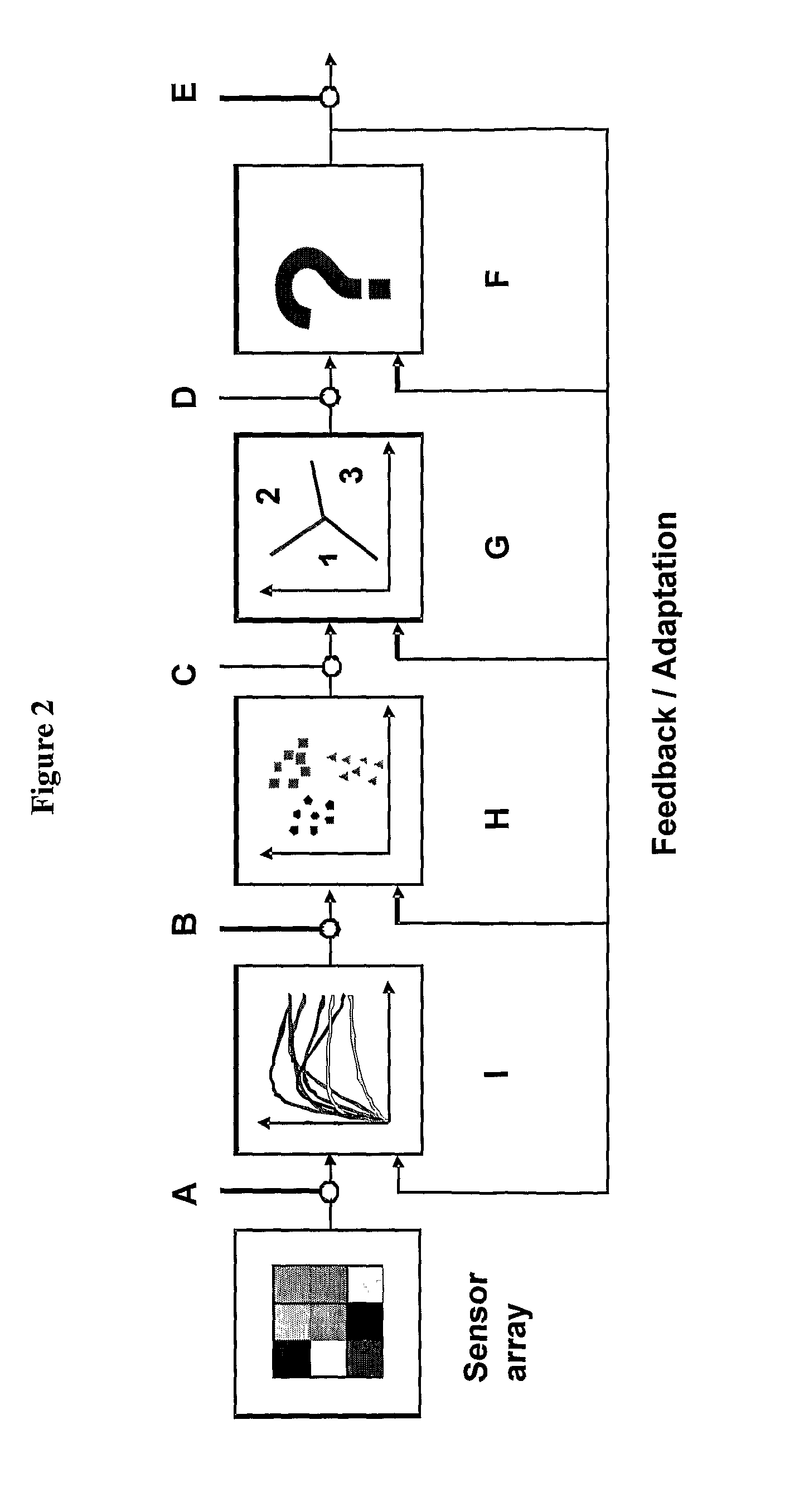Chemical sensors based on cubic nanoparticles capped with an organic coating for detecting explosives
a technology of organic coating and chemical sensors, applied in chemical methods analysis, instruments, suspensions, etc., can solve the problems of limited application, limited contact interface between adjacent spherical nanoparticles, and limited area, so as to enhance the efficacy of electron transfer, improve signal-to-noise ratio, and improve the effect of sensing applications
- Summary
- Abstract
- Description
- Claims
- Application Information
AI Technical Summary
Benefits of technology
Problems solved by technology
Method used
Image
Examples
example 1
Production of Au Cubic Nanoparticles Capped with an Organic Coating (Cubic NPCOCs)
[0105]The synthesis of cubic nanoparticles having dimensions of approximately 25-35 nm (FIG. 3A) was performed using a modified seed-mediated growth procedure, Specifically, gold seeds, having diameters of 1-3.5 nm, were synthesized using borohydride reduction of gold salt in the presence of CTAB as a capping agent. In a typical procedure, 0.25 ml of 0.01M HAuCl4.3H2O solution was added to 7.5 ml of 0.1M CTAB solution. The solution was gently shaken, followed by the addition of 0.6 ml of an aqueous 0.01M NaBH4 solution cooled down to ice temperatures, and rapid shaking for approximately 2 minutes. The solution was then stored at 25° C. for subsequent use.
[0106]Growth of cubic nanoparticles from Au seeds was performed by gentle reduction of the metal salt (HAuCl4) on pre-prepared Au nucleation centers using a weak reducing agent (L-ascorbic acid) in the presence of a stabilizing agent, preferably CTAB. ...
example 2
Characterization of Au Cubic Nanoparticles Capped with an Organic Coating (Cubic NPCOCs)
[0109]Transmission electron micrographs clearly show the cubic morphology of the gold nanoparticles of the present invention in comparison to the spherical nanoparticles (FIGS. 3A and 3B, respectively). The nanoparticles obtained were uniform in size and their dimensions ranged approximately between 25 to 35 nanometers. Optical absorption spectra of aqueous solutions containing 50 nm cubic and 25 nm spherical Au nanoparticles stabilized by bi-layer of CTAB surfactant are presented in FIG. 4 (dotted line and solid line, respectively). Nanoparticles possessing cubic morphology as well as nanoparticles possessing spherical morphology showed a single intense and sharp plasmon absorption band at approximately 535 nm. However, the plasmon absorption peak of the cubic Au nanoparticles was slightly red-shifted compared to that of the spherical ones. Without being bound by any theory or mechanism of actio...
example 3
Morphology of Au Cubic Nanoparticles Capped with an Organic Coating (Cubic NPCOCs) at Different Stages of Growth
[0110]Gold (Au) nanoparticles were quenched at different stages of the growth reaction and intermediate growth products were characterized (Haick & Dovgolevsky, Small, 2008, 4(11): 2059; published after the priority document IL 190475). Structural and morphological analysis indicated that nanocubes are formed in the following shape transformation sequence: quasi-spherical shapes are transformed to decahedrons, to cuboctahedrons, and finally to nanocubes. FIGS. 5A-5H show transmission electron micrographs of Au nanoparticles growth products obtained at different quenching times. Au seeds that were grown for 1.5 minutes showed 17-23 nm quasi-spherical shapes (FIG. 5 A). After a reaction time of 2.5 minutes, over 92% of the quasi-spherical nanoparticles kept their shape (approximate sizes 25-27 nm; FIG. 5B). The remaining Au nanoparticles (less than 8%) transformed to cubic-l...
PUM
| Property | Measurement | Unit |
|---|---|---|
| diameters | aaaaa | aaaaa |
| diameters | aaaaa | aaaaa |
| size | aaaaa | aaaaa |
Abstract
Description
Claims
Application Information
 Login to View More
Login to View More - R&D
- Intellectual Property
- Life Sciences
- Materials
- Tech Scout
- Unparalleled Data Quality
- Higher Quality Content
- 60% Fewer Hallucinations
Browse by: Latest US Patents, China's latest patents, Technical Efficacy Thesaurus, Application Domain, Technology Topic, Popular Technical Reports.
© 2025 PatSnap. All rights reserved.Legal|Privacy policy|Modern Slavery Act Transparency Statement|Sitemap|About US| Contact US: help@patsnap.com



